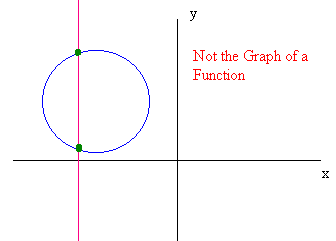Relations and Functions
A relation is a rule that takes an input from a set (called the domain) and gives one or more outputs of another set (called the range).
Examples
-
(0,0), (4,4), (0,3), (2,1)
-
y = 2x
-

The circle is a relation. We can go from an x-coordinate to the y-coordinates of the circle that have that x-coordinate.
A function is a relation such that for every input there is exactly one output.
Examples:
Examples 2 and 3 above are functions, whereas examples 1 and 4 are not functions.
Determining the Domain of a Function
Rule 1: The domain of a polynomial is the set of all real numbers.
Example:
For
f(x) = 3x2 + 2x - 1
the domain is the set of all real numbers.
Rule 2: The domain of a rational function (poly)/(poly) is the set of all real numbers except where the denominator is 0.
Example:
For
x - 1
f(x) =
x + 1
the domain is all real numbers except where x = -1.
Rule 3: The domain of a square root function is all real numbers that make the inside of the square root positive.
Example:
Find the domain of
![]()
Solution:
We set up the inequality
x2 - x - 6 > 0
and use our steps of quadratic inequalities to solve. Factoring we get
(x - 3) (x + 2) > 0
Putting -2 and 3 on a number line, gives three regions. The table shows

| x+2 | x - 3 | Total | |
| Left (-3) | - |
- |
+ |
| Middle(0) | + |
- |
- |
| Right(4) | + |
+ |
+ |
Hence the solution is
(-![]() ,-2]
U [3,
,-2]
U [3,![]() )
)

The Vertical Line Test
If every vertical line passes through the graph at most once then the graph is the graph of a function.
Example
The Circle is not the graph of a function since there are vertical lines that cross it twice.


Back to the Functions Home Page
Back to the Intermediate Algebra (Math 154) Home Page